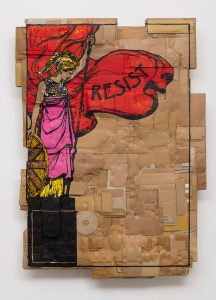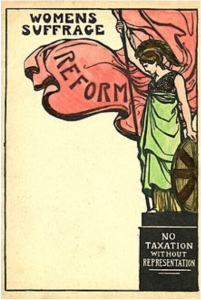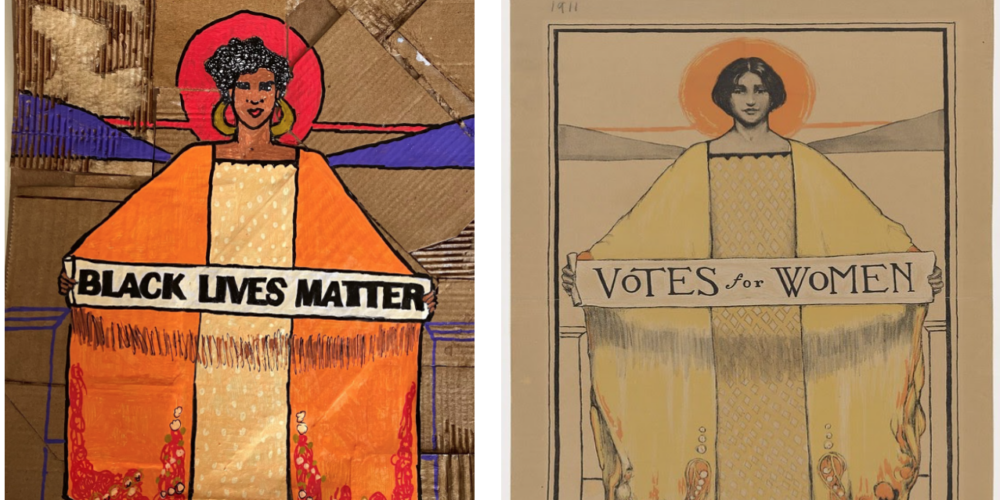
Andrea Bowers’s Resist (Illustration Designed by Suffrage Atelier, London, 1909) uses found, recycled cardboard pieces to create a backdrop for a powerful figure with a banner that says “resist.” Like remixing in music—when artists cover or update songs—the artist has taken existing materials and images to give them a new life yet a sustained message. In this activity, we will use similar materials and reference images to create recycled and reimagined protest art.
Ages: 10 years to Adults
Time It Takes: 60–90 minutes
What We’re Going To Do:
- Cardboard collage
- Paper collage
- Redesign a historical image
You’ll Need:
- Posterboard, preferably between 8.5 x 11 inches and 9 x 12 inches
- Cardboard or cardboard-like paper, such as recycled brown paper or close-up images of cardboard you print from the internet with the white edges trimmed off
- Suffragette Movement Art (collected from online research)
- White paper
- Acrylic Markers or Permanent Markers
- Pencils
- A clear varnish, such as clear gesso or clear glue and water
Before We Start:
Let’s look at the Andrea Bowers’ Resist (Illustration Designed by Suffrage Atelier, London, 1909), 2017 (shown above), and the original image (shown below).

The artist’s use of cardboard was inspired by handmade protest signs she saw at Zuccotti Park, during Occupy Wall Street, and her concerns around climate change and waste. On the surface of the cardboard, Bowers uses acrylic markers to draw a figure taken from a poster and postcard design made by an artist collective in London in the early 1900s. This collective, called Suffrage Atelier (suffrage means right to vote, atelier means workshop), used their artworks to campaign for women’s right to vote. Bowers replaces the word “Reform” from the original design to say “Resist,” updating the call to action to be broader, more inclusive, and reminding us that the fight for equality still continues 100 years later.
Think About:
- Compare Bowers’s work and the original art from Suffrage Atelier: How are they similar? How are they different?
- Why do you think Bowers changed from “Reform”—the word used in the Suffrage Atelier—to “Resist”?
- What else do you think is meaningful about the artist’s choice to use recycled cardboard?
- What word or a phrase would you stand up for?
Art Activity
- Prepare a piece of poster board the size, no larger than 9 x 12 inches
- There are two approaches to creating a cardboard background: a cardboard collage or a cardboard-like paper collage.
- If doing a cardboard collage, cut small pieces of various shapes and sizes, such as squares, rectangles, triangles. Arrange them on the poster board and then glue them down. After you have covered the area, apply a clear varnish to make the surface even, which makes it easier to apply acrylic or permanent markers.
- If doing a cardboard-like paper collage, cut the paper into various sizes and shapes, arrange on the poster board, and glue down the pieces.
- Find an image on the internet from the suffrage movement. Draw this image on paper but remember to make it your own. Make it your own by giving more detail to your protest figure by adding physical characteristics, and add your own protest message.
- Once you have finished drawing, go over your pencil details with a black permanent marker and add color with permanent markers or acrylic markers.
- Cut the protest figure out and apply it to your cardboard or cardboard-like paper collage with glue. Give it a few minutes to set. You can add a layer of varnish and let it dry, if you choose. You now have a completed work of art with your own protest message.
Terms
- Suffrage Movement
- Resistance
- Reform
- Collage
Protest Recycled was inspired by Andrea Bowers’s Resist (Illustration Designed by Suffrage Atelier, London, 1909).
